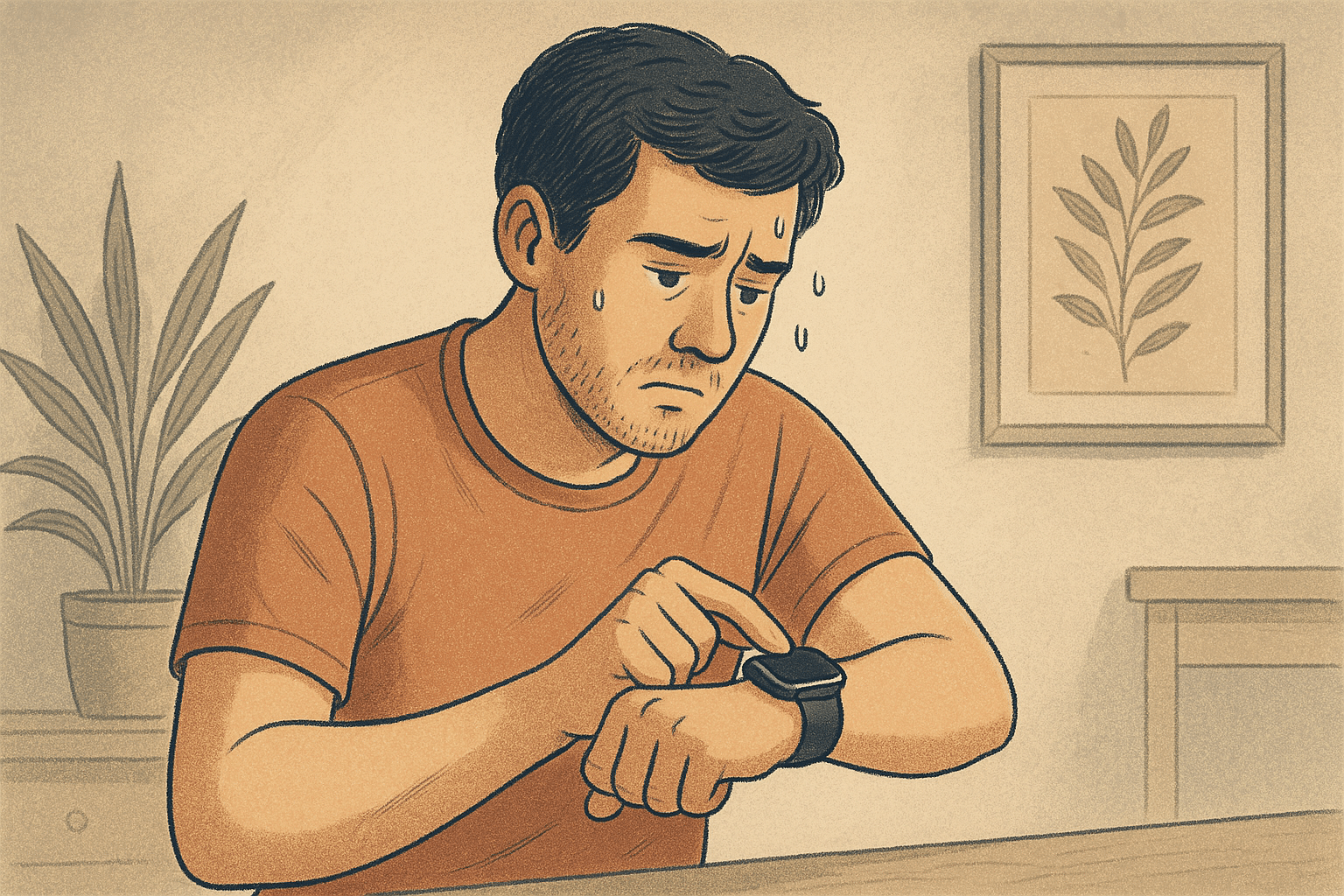Key Takeaways
- Panic attacks that seem to occur “out of nowhere” often have subtle triggers that aren’t immediately obvious but can be identified with careful observation.
- Internal cues like physical sensations, thoughts, and emotions are more common triggers for unexpected panic attacks than external situations.
- The “fear of fear” cycle, where anxiety about having another panic attack actually triggers one, is a common pattern in panic disorder.
- Biological factors including genetics, brain chemistry, and certain medical conditions can contribute to the likelihood of experiencing sudden panic attacks.
- At A Mission for Michael, our specialized clinical team combines CBT, medication management when appropriate, and personalized strategies to help clients identify triggers, break panic cycles, and achieve long-term relief from seemingly random attacks.
Panic Attacks Without Warning
Unexpected panic attacks are defined as those that occur without an obvious external trigger. You might be watching television, driving to work, or even sleeping when suddenly, panic strikes. These attacks can be particularly distressing because their seemingly random nature makes them feel unpredictable and uncontrollable.
One moment you’re fine, and the next you’re in the grip of intense fear. However, research consistently shows that even seemingly random panic attacks typically have triggers, they’re just not always obvious ones.
Founded in 2010, A Mission For Michael (AMFM) offers specialized mental health care across California, Minnesota, and Virginia. Our accredited facilities provide residential and outpatient programs, utilizing evidence-based therapies such as CBT, DBT, and EMDR.
Our dedicated team of licensed professionals ensures every client receives the best care possible, supported by accreditation from The Joint Commission. We are committed to safety and personalized treatment plans.
Hidden Triggers Behind “Random” Attacks
Internal vs. External Triggers
External triggers are relatively easy to identify: giving a presentation, being in a crowded space, or driving on a highway. Internal triggers, however, are much more subtle and often responsible for seemingly random attacks. These can include slight changes in body sensations, specific thoughts, emotions, or even certain physical positions.
For example, a slight increase in heart rate from climbing stairs or drinking coffee might go unnoticed by most people. But for someone predisposed to panic, this minor physiological change might be unconsciously interpreted as dangerous, triggering the body’s alarm system.
Anxiety About Anxiety
One of the most common internal triggers we see is what’s called the “fear of fear” cycle. This occurs when you become hypervigilant about your body sensations, constantly monitoring for any sign that panic might be starting.

You might find yourself constantly listening to subtle changes in your heart beat.
Ironically, this hyperawareness often triggers the very thing you’re trying to prevent. A slight increase in heart rate gets noticed, which causes anxiety, which further increases heart rate, which causes more anxiety, and so on until a full panic attack develops.
Subconscious Stress Accumulation
What many people don’t realize is that stress can accumulate below the threshold of conscious awareness. You might think you’re handling life’s pressures well, but your body keeps score.
You might later experience panic attacks during periods of apparent calm, after the stressful period has ended. This “let-down effect” happens when your body finally relaxes after being in a prolonged state of tension, almost like a pressure valve releasing.
Fear Response Activation
The human fear response is designed to activate quickly and powerfully, it’s a survival mechanism that doesn’t wait for conscious processing. When your amygdala (the brain’s fear center) detects a potential threat, it triggers a cascade of physiological responses before your conscious mind has time to analyze the situation.
This means your body can be in full panic mode before you’ve even consciously registered what triggered it, making the attack seem to come from nowhere.
Biological Causes
Brain Chemistry Imbalances
Neurotransmitters, the chemical messengers in your brain, play a crucial role in regulating mood and anxiety. Imbalances in serotonin, GABA, and norepinephrine have all been implicated in panic disorder.
These chemical messengers help regulate the brain’s alarm system, and when they’re out of balance, that system may become hypersensitive, triggering false alarms (panic attacks) without legitimate threats.
Amygdala Dysfunction
Studies have shown that people with panic disorder often have an overactive amygdala, the brain’s fear processing center. This hyperresponsiveness means the brain’s alarm system has a hair trigger, activating the fight-or-flight response with minimal provocation.
Someone with an overactive amygdala might experience a full-blown panic response to subtle internal sensations that others would barely notice.
Genetic Factors
Family history significantly increases the risk of developing panic disorder, suggesting a strong genetic component. If you have a first-degree relative with panic disorder, your risk increases approximately four-fold.
These genetic influences likely affect how your brain processes fear and anxiety, making you more susceptible to experiencing panic attacks that seem to come out of nowhere.
Tracking Your Panic Patterns
Learning to identify the subtle triggers behind seemingly random panic attacks is a powerful step toward managing them. The process starts with detailed record keeping and tracking.

We recommend keeping a panic diary that records not just when attacks occur, but what was happening before them, physically, emotionally, and situationally.
Over time, patterns typically emerge that can help you anticipate and intervene before panic escalates. Additionally, taking a regular inventory of stressors in your life, including those you might be minimizing or denying can reveal connections between life circumstances and panic episodes. This might include work pressure, relationship difficulties, financial concerns, health worries, or major life transitions. This proactive approach often reduces the likelihood of stress emerging as panic attacks later.
Effective Coping Strategies
Breathing Techniques
When panic begins, breathing often becomes rapid and shallow, which can worsen symptoms by creating carbon dioxide imbalances. Diaphragmatic breathing (also called belly breathing) counteracts this pattern and activates the parasympathetic nervous system, your body’s natural calming mechanism.
Grounding Exercises
Panic often involves a feeling of detachment from reality or being “in your head.” Grounding techniques help counter this by connecting you to the present moment through your senses. The popular 5-4-3-2-1 technique involves identifying 5 things you can see, 4 things you can touch, 3 things you can hear, 2 things you can smell, and 1 thing you can taste. These practices interrupt the spiral of panic thoughts by redirecting attention outward rather than inward.
Progressive Muscle Relaxation
Physical tension both contributes to and results from panic. Progressive muscle relaxation involves systematically tensing and then relaxing different muscle groups throughout the body. This practice both relieves physical tension and creates awareness of what relaxation actually feels like, a sensation many chronic anxiety sufferers have forgotten.
Professional Treatment Options

While self-help strategies can be effective, professional treatment often provides more comprehensive and lasting relief, especially for recurrent panic attacks.
Cognitive Behavioral Therapy
Cognitive Behavioral Therapy (CBT) is considered the gold standard treatment for panic disorder. This structured approach helps identify and change the thought patterns and behaviors that maintain panic cycles.
Studies consistently show that CBT produces significant improvement in people with panic disorder, with many becoming panic-free. Treatment typically lasts 12–16 sessions, though some people benefit from longer-term therapy, especially if they have comorbid conditions or complex trauma histories.
Medication Approaches
Several medication options can effectively reduce or eliminate panic attacks. Selective serotonin reuptake inhibitors (SSRIs) and serotonin-norepinephrine reuptake inhibitors (SNRIs) are typically first-line treatments, as they address the underlying anxiety and the panic attacks themselves.
While these medications take several weeks to reach full effectiveness, they provide long-term relief for many people.
When To Seek Help
If you’re experiencing panic attacks that interfere with your daily life, it’s time to seek professional help. Warning signs that indicate the need for treatment include: avoiding situations due to fear of having a panic attack, experiencing panic attacks frequently (more than once a month), developing fear of the panic attacks themselves, or using alcohol to manage anxiety symptoms.
It’s particularly important to seek help if you’re having thoughts of harming yourself, as panic disorder can sometimes lead to depression and suicidal thinking. Panic disorder is highly treatable, and seeking help early often leads to better outcomes.
Finding Freedom from Unpredictable Panic with AMFM
At AMFM, we specialize in helping individuals decode their unique panic patterns and develop effective strategies for long-term relief. Our comprehensive approach goes beyond temporary symptom management to address the root causes of seemingly random attacks.

With healthcare facilities in California, Virginia, and Washington we make sure you get the best possible treatment in the best environment.
Through evidence-based treatments like Cognitive Behavioral Therapy, mindfulness training, and personalized coping strategies, to intensive residential care or outpatient programs, we help clients transform from feeling helpless against unpredictable panic to confidence in their ability to manage anxiety.
You don’t have to continue living in fear of the next attack. Our experienced clinical team understands that panic attacks, while terrifying, are highly treatable. With proper support and proven treatment methods, most people experience significant improvement or become completely panic-free.
Take the first step toward freedom from unpredictable panic. Contact AMFM today to begin your journey toward lasting peace of mind.
Frequently Asked Questions (FAQ)
Can panic attacks cause physical damage?
Despite how they feel, panic attacks do not cause physical damage to your body. The sensations you experience during panic, racing heart, chest pain, difficulty breathing. can feel extremely frightening and even life-threatening, but they don’t actually harm your cardiovascular system or other organs. Your body is experiencing a surge of stress hormones that trigger these intense physical reactions, but these hormones and their effects are temporary and do not leave lasting physical damage.
How long does a typical panic attack last?
Most panic attacks reach their peak intensity within 10 minutes and begin to subside within 20–30 minutes. While some people report panic symptoms lasting longer, these extended episodes often represent multiple panic attacks back-to-back or high anxiety that persists after the acute panic has subsided.
Are panic attacks different from anxiety attacks?
“Anxiety attack” is not a formal clinical term, though it’s commonly used to describe periods of intense anxiety. The main difference is that panic attacks typically have a sudden onset and include intense physical symptoms, while anxiety tends to build gradually and may be less physically intense (though still quite uncomfortable).
Can children experience panic attacks?
Yes, children can and do experience panic attacks, though they may describe their symptoms differently than adults. Children might complain of stomach aches, feeling dizzy, or being unable to breathe rather than identifying what they’re experiencing as anxiety or panic. They may also become clingy, irritable, or try to avoid situations where they’ve previously felt panicky.
How does AMFM help people overcome seemingly random panic attacks?
AMFM specializes in helping clients become “detectives” of their own panic patterns through detailed tracking, identifying subtle triggers, and developing personalized coping strategies. Our evidence-based approach combines Cognitive Behavioral Therapy, mindfulness techniques, and when appropriate, medication management to help clients regain control and achieve lasting relief from panic attacks.












